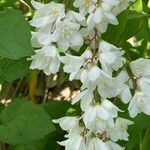Shrubs 5–20 dm. Branches spreading or arching. Leaves: petiole 2–8 mm, glabrous; blade lanceolate, elliptic-lanceolate, oblong-lanceolate, or broadly ovate-lanceolate, 30–35 × 15–30 mm, base cuneate or rounded, margins unevenly serrate, apex acuminate, abaxial surface light green, glabrous or glabrate, adaxial dark green, sparsely stellate-pubescent. Inflorescences usually racemes or narrow panicles, open, (2–)10–50-flowered, sometimes flowers solitary, 8–12 × 3–6 cm, glabrous; peduncle 5–10 mm, glabrous. Pedicels 5–10 mm, glabrous. Flowers faintly fragrant, 15–20 mm; hypanthium campanulate, 2.5–3 × 2.5–3 mm, glabrous or short-hairy; sepals triangular, 1.5–1.7 × 1–1.5 mm, apex obtuse, surfaces glabrous or glabrate; petals valvate, white, oblong or oblong-lanceolate, 10–12(–15) × 4–6 mm, glabrous or sparsely stellate-pubescent abaxially, glabrous adaxially; filaments dorsiventrally flattened, narrowly oblong or subulate, outer 5–6 mm, apex 2-lobed or not lobed, inner 3–4 mm, apex 2-lobed; styles 3, 4–7 mm. Capsules hemispheric, 6–7 × 5–6 mm. Seeds 1.2–1.5 mm. 2n = 26 (Asia).
More
Shrubs ca. 1.5 m tall. Flowering branchlets brown, 5-17 cm, ca. 4-leaved, glabrous. Petiole 2-4 mm; leaf blade lanceolate, elliptic-lanceolate, or broadly ovate-lanceolate, 3-3.5 × 1-1.2 cm, papery, abaxially appressed 4-or 5(or 6)-rayed stellate hairy, adaxially 3-or 4-rayed stellate hairy, veins in 3 or 4 pairs, base cuneate, margin serrulate, apex acuminate. Inflorescences racemose or narrowly paniculate, 8-12 cm, 12-25-flowered, glabrous; pedicels slender, 5-10 mm. Calyx tube 2.5-3 × ca. 2.5 mm; lobes ovate or ovate-deltoid, ca. 1.5 cm, glabrous or sparsely hairy. Petals imbricate, white, oblong or oblong-lanceolate, 10-12 × 4-6 mm. Outer stamens 5-6 mm; filaments 2-dentate at apex or subulate and toothless, teeth (if present) not reaching anthers; anthers stalked, ovoid. Inner filaments all 2-dentate at apex. Styles 3, subequaling or longer than outer stamens. Capsule hemispheric, ca. 5 mm in diam. Fl. Mar-Apr.









